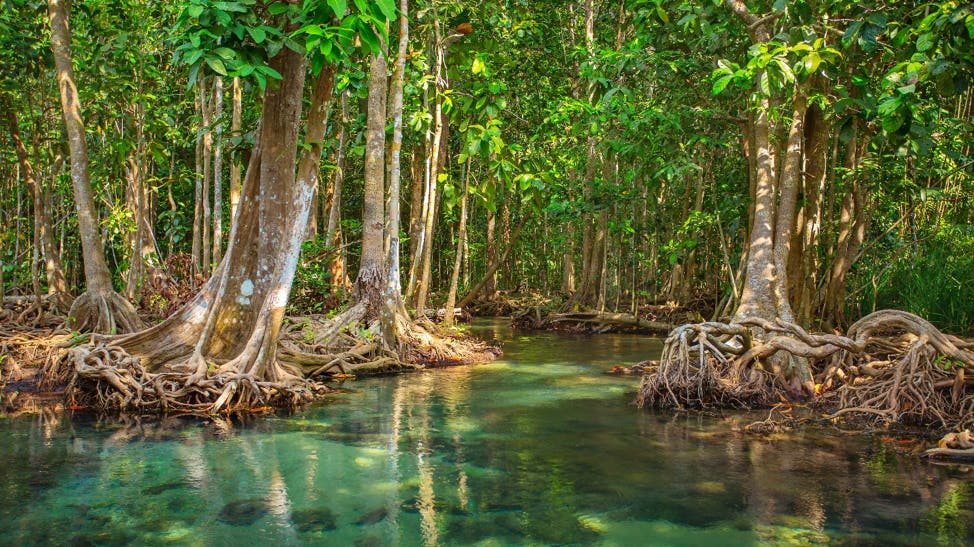When it comes to sucking up carbon, not all trees are equal
Trees are a large part of the climate change solution, with their ability to suck carbon out of the atmosphere and store it.

[Apr 1, 2022: Janet Davison]
Mangroves, which have been in decline in recent years, can sequester up to 10 times as much carbon compared to terrestrial forests. (CREDIT: Creative Commons)
Trees are a large part of the climate change solution, with their ability to suck carbon out of the atmosphere and store it.
As with so much else, however, there is nuance — we need to be careful about assuming trees alone can save us. With wildfires and natural die-off, trees sometimes give off more carbon than they absorb.
And when it comes to sequestration, some trees and their ecosystems appear to be more effective than others over time.
With that in mind, it is notable to see a new tree-related carbon project finding favour with some high-profile corporations. Proctor and Gamble, Apple and Gucci have all announced projects to protect and restore the mangrove, a woody tree or shrub living in salty coastlines in the tropics and subtropics.
Mangroves (like the one being repopulated in the photo above) hold a particular allure as carbon sinks. "At a high level, [mangroves] are salty and wet, and that keeps the carbon from breaking down," according to Jen Howard, senior director of the blue carbon program for the American non-profit Conservation International.
Conservation International says mangroves, which have been in decline in recent years, can sequester up to 10 times as much carbon compared to terrestrial forests.
Related Stories
Tania Clerac, dean of the school of environmental and natural resource sciences at Fleming College in Peterborough, Ont., said via email that mangroves and terrestrial systems "do store carbon in different ways, with trees storing carbon in their biomass, and mangroves sequestering it in their soil."
"The soil among mangroves has low biological activity and therefore that carbon is released slowly."
Clerac suggests mangroves shouldn't really be viewed as an either/or scenario when it comes to sequestration, or better or worse than others, but as one possibility. "Especially given that the solution of mangroves is not a possibility in Canada."
This country's managed forests have been a "significant carbon sink," says Natural Resources Canada on its website, given how the forests have steadily added carbon to that which was already stored.
But the NRC also notes that "in recent decades ... the situation has reversed in some years: Canada's forests have become carbon sources, releasing more carbon into the atmosphere than they are accumulating in any given year."
Several factors came into play, including an increase in the area consumed by wildfires annually, and dramatic shifts in yearly harvest rates, with increases in the 1990s and then sharp decreases with the global economic recession, NRC said.
Environmental activists have long called for protection of old-growth forests in particular, noting their carbon storage abilities, along with their ecosystems and the rich biodiversity found within them.
But what about on an individual level? Could a home- or landowner make a difference by planting some more trees?
"In terms of non-forest conditions such as a yard that is currently mown lawn or low-density garden plants, including more trees will help improve carbon sequestration," Clerac said. And some trees could be more effective than others.
Deciduous species are the best on a carbon-per-centimetre-diameter basis (CREDIT: Creative Commons)
"As far as planting individual species on a carbon-per-centimetre-diameter basis, the best are deciduous species, often called hardwoods, particularly those that are long-lived, such as sugar maple, oak, black walnut and hickory," said Clerac.
Some softwoods, such as red pine and white pine, are also good at storing carbon. Next come softer deciduous trees like birch, red or silver maple and poplar. Conifers like cedar or larch sequester less carbon.
But again, there is nuance to this.
"This does not account for the rate of growth, so although some [trees] may grow more slowly and in the short term store less carbon, in the long term they are longer-lived and will store more carbon," Clerac said.
She has an additional suggestion for increasing the carbon storage abilities of trees: doing what you can to fight invasive species, such as the emerald ash borer, which has killed ash trees throughout eastern North America.
"This beetle did not have a fantastic ability to spread on its own, yet it did," Clerac said, with people moving infested wood around, which led to "a lot of tree mortality and carbon release."
"When someone reports an invasive species and follows rules around moving wood products, the health of our trees and forests benefits, and so does their ability to sequester carbon."
Note: Materials provided by Janet Davison. Content may be edited for style and length.
Like these kind of feel good stories? Get the Brighter Side of News' newsletter.
Tags: #Global_Good_News, #Trees, #Green_Good_News, #Sequestration, #Science, #Research, #Carbon_Capture, #Global_Warming, #The_Brighter_Side_of_News
Joseph Shavit
Head Science News Writer | Communicating Innovation & Discovery
Based in Los Angeles, Joseph Shavit is an accomplished science journalist, head science news writer and co-founder at The Brighter Side of News, where he translates cutting-edge discoveries into compelling stories for a broad audience. With a strong background spanning science, business, product management, media leadership, and entrepreneurship, Joseph brings a unique perspective to science communication. His expertise allows him to uncover the intersection of technological advancements and market potential, shedding light on how groundbreaking research evolves into transformative products and industries.



